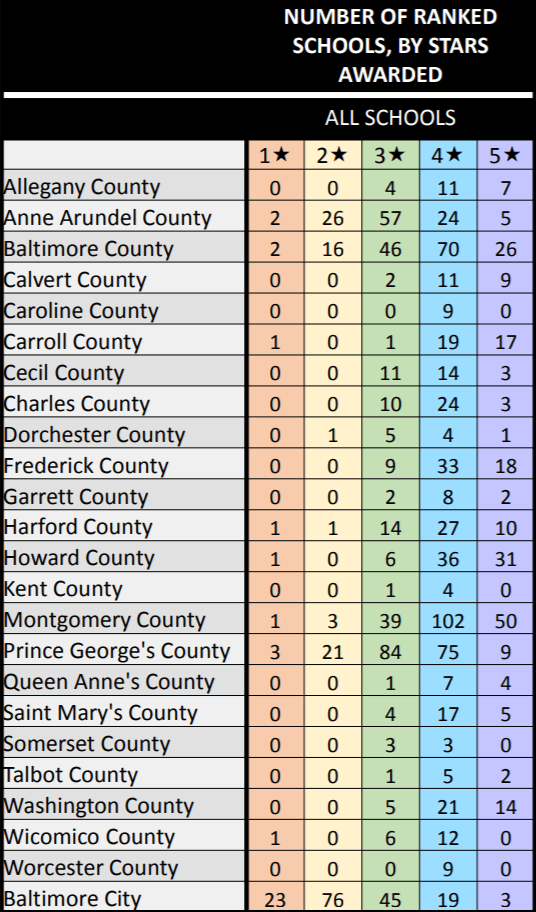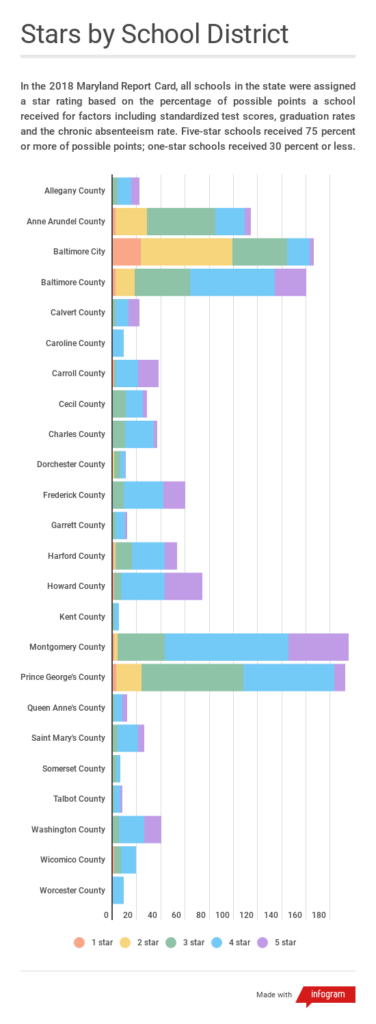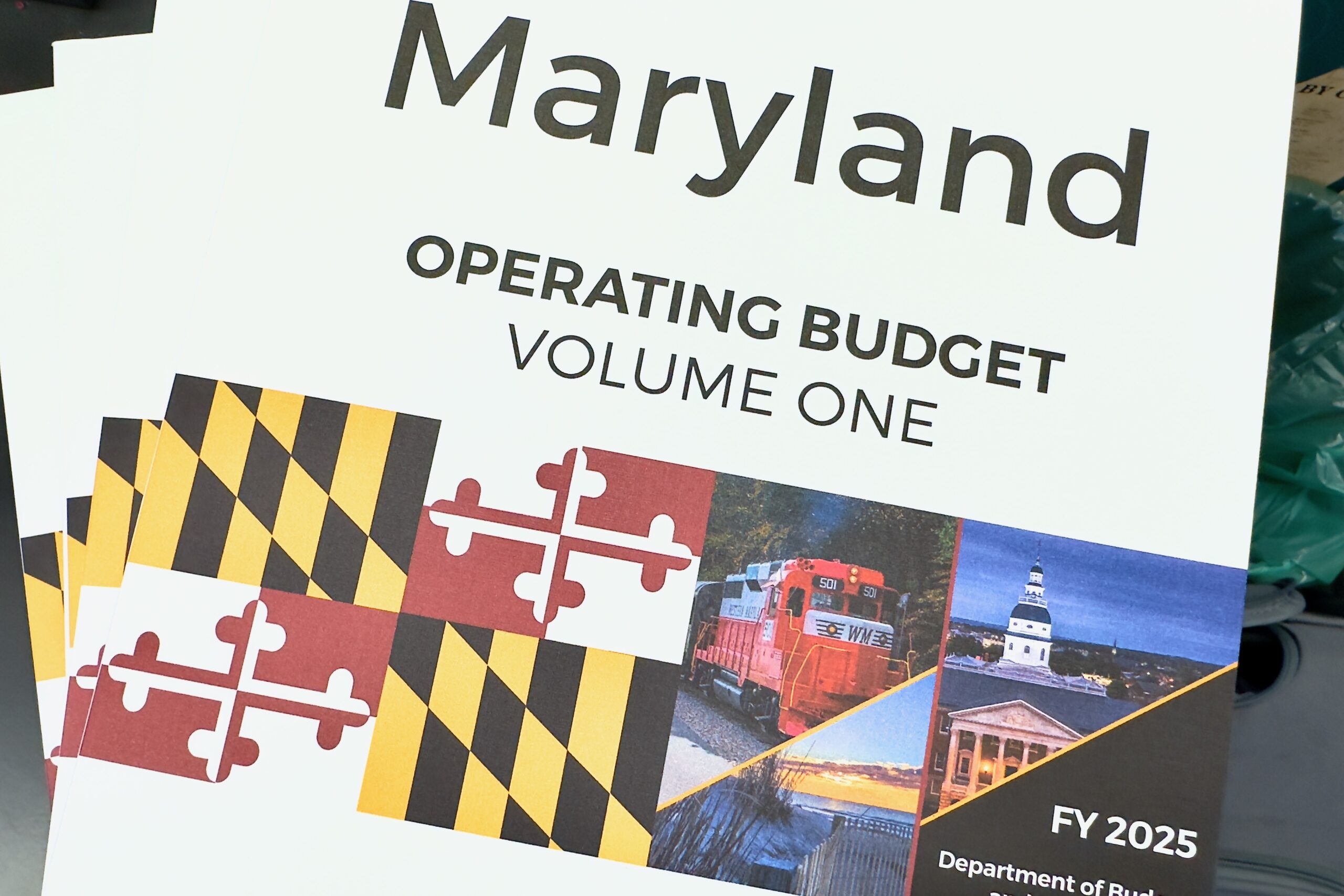With New Report Card, State Schools Receive a Star Rating
About 17 percent of Maryland’s schools are operating at the highest level, according to new accountability scores released by the Maryland State Department of Education on Tuesday.
A little less than 3 percent of schools in the state received the lowest accountability score in the new measurement scheme, one star.
Statewide, there are:
- 219 five-star schools,
- 564 four-star schools,
- 356 three-star schools,
- 145 two-star schools, and
- 35 one-star schools.
Montgomery County is home to the most five-star schools, 50. Baltimore City has the most one-star schools, 23.
Three- and four-star ratings were most common statewide.

Maryland State Department of Education graphic

The Report Card was generally defined in legislation passed by the General Assembly in 2017; the Maryland State Board of Education has since worked to refine the factors and calculations that lead to the star ratings and a percentile ranking. The 2018 Report Card has been lauded as the most complete picture of school and school system performance in state history.
“Our goal is to improve every school throughout our State, and prepare every student for a bright future,” Karen Salmon, state superintendent of schools said in a written statement. “The new Maryland Report Card will help parents, educators, policymakers, and the general public gain a better understanding about how each school is doing based on our accountability measures. Together we are working toward making sure our schools are the best they can be.”
The new accountability scheme, required under the federal Every Student Succeeds Act, includes a broad selection of performance indicators beyond test scores to measure how schools are doing.
Different factors figure into the scores for elementary, middle and high school students.
Elementary and middle schools earn points for improvements in student achievement over time. The graduation rate is included in high school stores. Other factors include the chronic absenteeism rate, progress in achieving English language proficiency and access to a well-rounded curriculum. Academic achievement on standardized test scores still accounts for between 23 percent and 33 percent of a school’s point total, depending on grade level. Factors like student growth and graduation rates are based in performance on tests as well.
In the future, additional points will be available for a school’s performance on science and social studies exams and a survey of students and teachers.
As the state moves away from the current Partnership for Assessment of Readiness for College and Career (PARCC) exams, it remains unclear how factors like student growth, which accounts for 25 points in the ranking system for elementary and middle schools, will be calculated in the future.
After the federal government passed ESSA, education advocates and lawmakers pushed for a state accountability system that moved away from grades of A through F for schools, arguing that it painted too simplistic a picture of the complicated factors that go into school scores. It remains to be seen whether the same backlash will hit the star rating system.
“When reviewing the report cards for their school, educators and parents should look past the star rating and analyze the data points that factored into that score,” Maryland State Education Association President Cheryl Bost said Tuesday. “This year’s data is incomplete because it doesn’t include parent, educator, and student survey responses about the quality of the school. Instead, it relies too heavily on one standardized test—the PARCC assessment—that is going away after this year.”
Bost said the ratings will be meaningless if they don’t spur action for change at the local level.
“Ultimately, school accountability only works if educators and parents drive change in their schools and have sustainable funding available to put in place new strategies—whether it’s hiring more counselors or adding a wellness center with medical services,” Bost said in a written statement. “At a time when each of our schools is already underfunded by an average of $2 million every year, we encourage everyone to not only dig into the report cards but also to strongly advocate for the changes and funding that your school needs to improve.”
Under the new accountability system, lowest-performing schools, and schools with groups of students that are low-performing or consistently underperforming, must develop improvement action plans. Depending on how much improvement is needed, either the state or school system will guide and monitor the school’s progress with supports that could include leadership coaches, professional learning, additional staffing and programmatic changes.
The state’s new Report Card website also includes additional accountability data, including:
- Test results by exam type and student group;
- Breakdowns of other measures by student group and other factors; and
- Equity information, calculated as the gap between students in each student group.
Other basic information about school systems is already published on the website including enrollment, demographics, attendance rate and graduation rate.
The information is available at MDReportCard.org.




 Creative Commons Attribution
Creative Commons Attribution